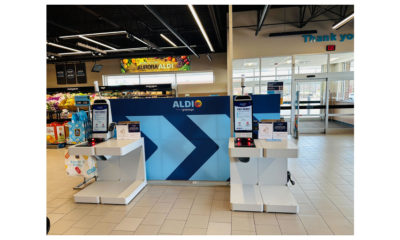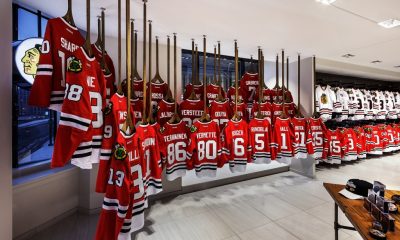For the first time in more than 10 years, the International Retail Design Conference slapped on some sunscreen and packed its pastel tunics for its return to Miami Beach. (The South Florida hurricane scares experienced at the 2002 and 2003 IRDCs could only deter our planning committee for so long.)
Attendees from an array of retail and design sectors arrived ready to soak up words of wisdom, network with their peers and share a little fun at the 14th annual gathering of creative professionals held this year at the Fontainebleau Hotel, September 3-5. This year’s lineup included keynote addresses from the likes of famed industrial designer Karim Rashid, NRF’s Dan Butler, WD Partners’ Lee Peterson and Retailer of the Year winner Walgreens, not to mention a bounty of engaging breakout sessions and case studies.
Here, we’ll revisit some of the most outstanding (and maybe a few outlandish) moments from IRDC 2014. For even more conference snippets and photos, search the hashtag #IRDC2014 on Twitter, visit irdconline.com or vmsd.com.
SETTING THE STAGE
“Whoever chose the Fontainebleau Hotel should get a raise,” said IRDC attendee Robert Ruscio, owner of the Montreal design firm Ruscio Studio. The beachfront hotel, designed by architect Morris Lapidus in the 50s, provided a dramatic backdrop for the conference with its over-the-top glamour, curving façade, grand “staircase to nowhere,” luxe chandeliers and bowtie-patterned marble floors. At night, the flooring in the hotel’s bar area glowed electric blue.
Day one of the conference kicked off with opening keynote speaker, industrial/interior designer and architect Karim Rashid, who took the stage to question the future of retail design. To a room packed with visual merchandisers and designers and other retail industry experts, Rashid challenged that “online is everything.”
He explained “the digital age has humanized us.” Since the advent of certain technologies, the shopper has become smarter, has more empowerment and more creative freedom. “I’m shocked by what we haven’t learned when I go into shops,” he said. “Retail has to make us feel alive … Technology is the catalyst for a retail experience.”
Advertisement
Bookending those sentiments was closing keynote speaker Lee Peterson, executive vp of creative services at Dublin, Ohio-based design firm WD Partners. “Stores as we know it are over,” he said. With online shopping conveniences, the shopper no longer has to go into a store, and according to Peterson’s presentation, shopper visits have fallen 5 percent every month for the last two years. So how can physical retailers stay relevant in the digital age? Peterson’s data-heavy study of shoppers – ranging from the millennial generation to Gen-X to baby boomers – showed the buy online, pick up in-store model, or BOPIS, ranked most appealing and is a potentially huge coup for brick-and-mortar retailers trying to remain afloat in this online-dominant environment.
Peterson’s presentation gave rendered examples of how retailers could incorporate BOPIS within their stores, then explained how physical locations can still have edge. “Technology should enhance the customer experience, not replace it,” Peterson said. “The store should become a social playground that’s less about buying and selling but [more about] engaging and interacting.”
SELLING JOY
This idea of “selling without selling” also appeared as a continual thread throughout several IRDC breakout sessions and case studies. In “Pirch: Developing the Immersive Store Experience,” Christian Davies, the executive creative director at Fitch (Columbus) teamed up with Jeffery Sears, the ceo for home lifestyle retailer Pirch (La Jolla, Calif.), and walked attendees through its extensive store re-branding and design. “We’re creating joy in someone’s life when [he or she] walks in the door,” Sears said. “It’s our job not to sell the customer things, but to make [his or her] day better.”
Similarly, VMSD European editor John Ryan suggested in his session on European retail trends thatstores are simply “planting the seed” for purchasing. Ryan referenced Levi’s London Commuter Workspace, a pop-up bike shop that offers free WiFi, free bike workshops and free repair services. “It doesn’t sell a thing,” he said. “It merely has its denim that’s designed for cycling displayed in the back while you’re hanging out waiting for your flat to be fixed.”
Session after session referenced the Bonobos Guideshop – perhaps one of the first physical stores to not stock actual merchandise – and while that model may not work for everyone, a few retailers on-hand discussed how they’re reducing stock and store footprints. “The stockroom and high inventory is a constraint,” said Stephen Bailey, marketing communications director for John Fluevog Shoes (Vancouver) in his session that explored strategies to reach the affluent traveler. The longstanding footwear retailer is testing a smaller airport-based concept that will carry only a single-size run of Fluevog’s current collection. Purchases can be made online and shipped to the customer’s home or the customer can pick up his selection in that city’s existing retail store. “They’re on vacation, they’re having a few drinks and making bad decisions,” says Bailey. “And we want to be a part of that.”
While European and American stores are sizing down – VMSD’s Ryan highlighted an IKEA in Stockholm that opened with a smaller footprint (and windows!) – stores in the Middle East are heading in the opposite direction. “What malls were in the 70s and 80s [in the U.S.],” said Sandeep Saligram, general manager at Landmark Group (Dubai), in his session that detailed retail innovation in the Middle East, “is what they are in the Middle East now.” Case in point: the Mall of the World, which is under construction in Dubai, will reportedly measure a whopping 8 million square feet.
Advertisement
WINNER, WINNER
Tim Welsh, Walgreens’ senior director of store design and planning, and Jeff Gormanous, director, store format & layout design, accepted the 2014 VMSD/Peter Glen Retailer of the Year award on behalf of the Deerfield, Ill.,-based drugstore chain. The convenience-based retailer breathed new life into its flagship stores and opened its first net-zero energy store in Evanston, Ill., a location that will generate more energy than it consumes. The store incorporates sustainable elements such as native landscaping, wind turbines and solar power. A video on Walgreens’ progression over the years honed in on a major point and part of why it was chosen as the Retailer of the Year: “Reinvention is the fuel of the 21st Century.”
DFS Group Ltd. (Hong Kong), represented by Tadaffee Taksen, design director, worldwide visual merchandising, took home the “Best in Show” award for VMSD’s 2014 International Visual Competition for semi-permanent, seasonal displays created for 14 luxury department stores and two airport stores around the world from folded paper, emulating the ancient art of origami. Harry Cunningham, svp, store planning and design, and Marco Oppici, vp of store planning and design for Saks Fifth Avenue accepted the 2014 Retail Renovation of the Year award for Saks’ extensive renovation of its The Fifth Avenue Man/D-Bar location in Beverly Hills, Calif.
Another IRDC winner: Team Orange led by Theresa Borowski, creative director, Refraction Group (Foothill Ranch, Calif.), took home the coveted Iron Merchant challenge victory sash for their daring suspended mannequin display. This year’s competition tasked six teams to transform a mannequin using glam holiday-inspired props and a wig (the secret ingredient), plus a glittery crescent moon and the requirement to incorporate a musical element. Designers glued, cut and sketched – a few even bickered – till their creations came to life.
“If you don’t champion and campaign for store design and visual merchandising, then who will?” asked NRF’s Dan Butler in his general session that addressed creating support for store design in the C-suite. Next year, IRDC will be doing just that, taking its high energy and creative spirit to the indie, innovative and offbeat city of Austin, Texas.
Photography: Richard Cadan, Fairfield, Conn.


 Photo Gallery3 days ago
Photo Gallery3 days ago
 Headlines1 week ago
Headlines1 week ago
 Sector Spotlight2 weeks ago
Sector Spotlight2 weeks ago
 Headlines1 week ago
Headlines1 week ago
 Headlines4 days ago
Headlines4 days ago
 Headlines2 weeks ago
Headlines2 weeks ago
 Designer Dozen1 week ago
Designer Dozen1 week ago
 Headlines2 days ago
Headlines2 days ago
















































































